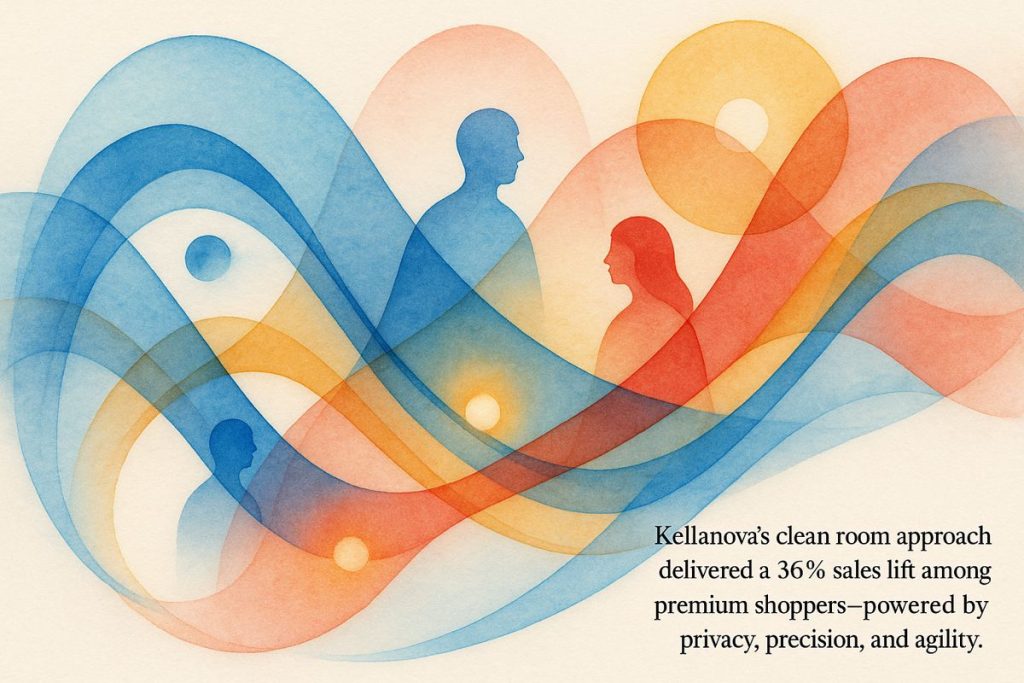By safely mixing its own shopper data with retailers’ sales info, Kellanova could target people much better—like finding out Pinterest, not TikTok, was the hot spot for Special K. This new way helped boost sales big time, especially among price-conscious and premium buyers, and even small gains meant millions for the company. The real secret wasn’t just fancy tech, but a bold culture that celebrates quick experiments and learning from mistakes, not just chasing the newest marketing fads.
Why did Kellanova adopt data clean rooms for its marketing?
Kellanova adopted data clean rooms to improve marketing ROI and targeting after third-party cookies and traditional attribution models became less effective. By securely combining first-party and retailer data, Kellanova increased sales among key segments and achieved 1–2% media effectiveness lifts across its brand portfolio, all while maintaining privacy compliance.
The Problem With Breadcrumbs: Why Kellanova Had to Change the Game
Some mornings the universe decides, with all the subtlety of a foghorn, to remind you that the old way simply won’t cut it. For Kellanova (née Kellogg’s—yes, the folks behind your childhood’s snap-crackle-and-pop), this revelation arrived not as a boardroom epiphany, but as a mounting frustration: marketing ROI had gone as fuzzy as an untuned radio. Third-party cookies? Crumbling. Attribution models? Decaying faster than a bowl of Rice Krispies. The plot twist? Kellanova didn’t dive into data clean rooms because of Silicon Valley FOMO, but because their bread-and-butter campaigns—like Special K’s UK push—were losing measurable ground.
I had to stop and ask myself: would I have been bold enough to question the sacred cow of “what worked last quarter” if I’d been steering that ship? Maybe not. There’s a lesson in that—sometimes inertia is the real villain.
So, rather than chase the latest martech bauble, Louise Cotterill (Global Senior Director of Insights and Intelligence) championed a different approach. “The most important thing to do is start with a business problem, because if you start with the technology, it will never land and never get embedded in the business,” she told Marketing Dive. What does that look like in practice? Chasing a modest 1–2% media effectiveness lift—a margin that, across Kellanova’s massive scale, is less a rounding error and more a windfall. A bit like realizing the spare change in your couch could buy you a new couch.
And honestly, who doesn’t love a numbers game where the stakes are real?
Clean Rooms: Where Data and Privacy Share an Awkward Pas de Deux
Let’s get a whiff of the tech itself. Imagine a hyperspectral vault—a data clean room—where Kellanova could let its own first-party data mingle, anonymously, with retailer sales figures and media exposure logs. No raw identities get out. Everyone’s privacy stays as locked-down as a Fabergé egg. Providers like LiveRamp, Snowflake, and the ever-present Google and Amazon aren’t just buzzwords here; they’re the scaffolding. Differential privacy and federated learning make sure the data handshake is both secure and, frankly, a little bit magical.
Here’s the crunchy bit: this architecture enabled the team to slice audiences not by tired demographics, but by living, breathing micro-behaviors. “Price-conscious lapsers,” “loyalists needing a nudge”—these aren’t just personas, they’re living archetypes. (Full disclosure: once, years ago, I built a “savvy snackers” segment for an FMCG brand, but I overfit the model until every university student became a target. Lesson learned—sometimes the map is not the territory.)
One vivid win: after the clean room’s algorithms puffed away behind the scenes, Kellanova spotted that Pinterest, not TikTok, was where the real Special K action was. Creative assets pivoted with the agility of a caffeinated squirrel, and campaign cycles shrank from glacial months to sprightly weeks (Kellanova Newsroom). You could practically smell the ozone of fresh ideas.
Impact That Crunches: Sales, Segments, and the Unseen Hand
So, did the earth move? Not quite—but the cash register sure did. Among price-conscious shoppers, sales rose 9%. Premium cohorts? Try 36%. I felt a flicker of envy—and, oddly, a pang of pride for a company willing to bet on math and consent rather than spray-and-pray advertising (Food Dive). Even those “small” 1–2% media effectiveness gains, drizzled across the vast Kellanova portfolio, mean millions in the aggregate. Sometimes, the butterfly effect is less poetic chaos and more financial serendipity.
Momentum breeds ambition: Pringles, Cheez-It, and other marquee brands joined the clean room renaissance. Expansion into new territories—especially those with EU-grade privacy regimes—wasn’t just a compliance hurdle but a proving ground (Retail Media World). If it works in London, it probably won’t break in Lisbon.
I admit, I once dismissed “incremental innovation” as corporate speak for “meh.” Turns out, it’s the way real progress smells: like possibility, tinged with a faint whiff of risk.
Culture Shock: Learning to Love Fast Fails (and the Occasional Head-Scratch)
But if you think this is a story about technology alone, you’ve missed the heartbeat. Charisse Hughes, Chief Growth Officer, champions an approach where failing fast—and, more crucially, failing cheap—is the highest virtue (Marketing Dive). It’s a little like jazz improvisation: sometimes you hit a bum note, but you keep playing, and suddenly you’ve invented something new. I remember a meeting where a data scientist sheepishly admitted a model bombed; instead of groans, there were grins. That’s
